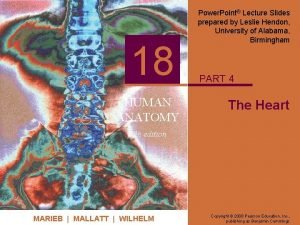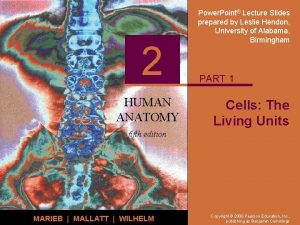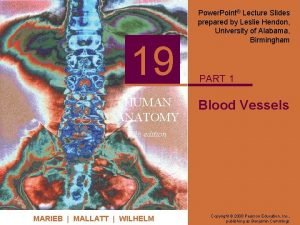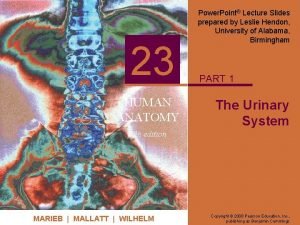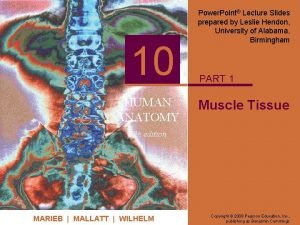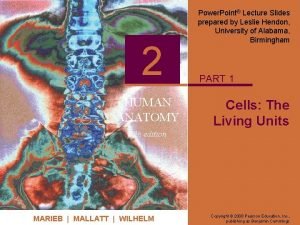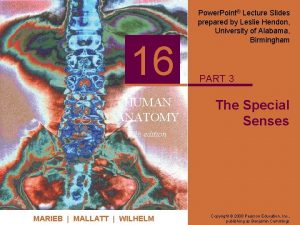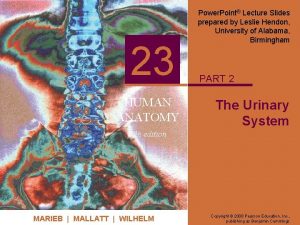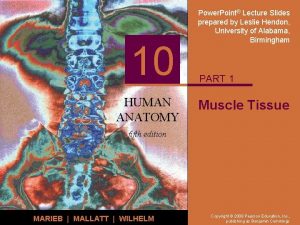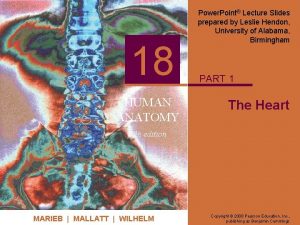9 HUMAN ANATOMY Power Point Lecture Slides prepared














- Slides: 14

9 HUMAN ANATOMY Power. Point® Lecture Slides prepared by Leslie Hendon, University of Alabama, Birmingham PART 3 Joints fifth edition MARIEB | MALLATT | WILHELM Copyright © 2008 Pearson Education, Inc. , publishing as Benjamin Cummings

Special Movements § § Inversion – turning the sole medially Eversion – turning the sole laterally PLAY Copyright © 2008 Pearson Education, Inc. , publishing as Benjamin Cummings Movement of the ankle and foot (a) Figure 9. 6 c

Special Movements § § Protraction – nonangular movement of jutting out the jaw Retraction – opposite movement to protraction Copyright © 2008 Pearson Education, Inc. , publishing as Benjamin Cummings Figure 9. 6 d

Special Movements § § Elevation – lifting a body superiorly Depression – moving the elevated part inferiorly Copyright © 2008 Pearson Education, Inc. , publishing as Benjamin Cummings Figure 9. 6 e

Special Movements § Opposition – movement of the thumb to touch the tips of other fingers Copyright © 2008 Pearson Education, Inc. , publishing as Benjamin Cummings Figure 9. 6 f

Synovial Joints Classified by Shape § Plane joint § Articular surfaces are flat planes § Short gliding movements are allowed § Intertarsal and intercarpal joints § Movements are nonaxial § Gliding does not involve rotation around any axis Copyright © 2008 Pearson Education, Inc. , publishing as Benjamin Cummings

Plane Joint Copyright © 2008 Pearson Education, Inc. , publishing as Benjamin Cummings Figure 9. 7 a

Synovial Joints Classified by Shape § Hinge joints § Cylindrical end of one bone fits into a trough on another bone § Angular movement is allowed in one plane § Elbow, ankle, and joints between phalanges § Movement is uniaxial – allows movement around one axis only Copyright © 2008 Pearson Education, Inc. , publishing as Benjamin Cummings

Hinge Joint Copyright © 2008 Pearson Education, Inc. , publishing as Benjamin Cummings Figure 9. 7 b

Pivot Joint Copyright © 2008 Pearson Education, Inc. , publishing as Benjamin Cummings Figure 9. 7 c

Synovial Joints Classified by Shape § Condyloid joints § Allow moving bone to travel § Side to side – abduction-adduction § Back and forth – flexion-extension § Classified as biaxial – movement occurs around two axes Copyright © 2008 Pearson Education, Inc. , publishing as Benjamin Cummings

Condyloid Joint Copyright © 2008 Pearson Education, Inc. , publishing as Benjamin Cummings Figure 9. 7 d

Synovial Joints Classified by Shape § Saddle joints § Each articular surface has concave and convex surfaces § Classified as biaxial joints Copyright © 2008 Pearson Education, Inc. , publishing as Benjamin Cummings

Synovial Joints Classified by Shape Copyright © 2008 Pearson Education, Inc. , publishing as Benjamin Cummings Figure 9. 7 e
 A small child slides down the four frictionless slides
A small child slides down the four frictionless slides Force and work relationship quick check
Force and work relationship quick check Principles of economics powerpoint lecture slides
Principles of economics powerpoint lecture slides Machine learning lecture slides
Machine learning lecture slides Business communication lecture slides
Business communication lecture slides 01:640:244 lecture notes - lecture 15: plat, idah, farad
01:640:244 lecture notes - lecture 15: plat, idah, farad Real power formula
Real power formula Power bi training powerpoint
Power bi training powerpoint Point point power
Point point power Anatomy histology slides
Anatomy histology slides Anatomy slides
Anatomy slides Power system dynamics and stability lecture notes
Power system dynamics and stability lecture notes Power system analysis lecture notes
Power system analysis lecture notes Power semiconductor devices lecture notes
Power semiconductor devices lecture notes Switch mode power supply lecture notes
Switch mode power supply lecture notes















